Opening Reception at Madelyn Jordon Fine Art on Friday
- Details
- Hits: 4049
 Madelyn Jordon Fine Art is pleased to announce Distilled Spirits, the gallery’s second solo show of work by Antonio Carreno. The exhibition will run from November 9 – December 31, 2012. An opening reception for the artist will be held on Friday, November 9 from 6-8PM. Previews and private showings are by appointment only.
Madelyn Jordon Fine Art is pleased to announce Distilled Spirits, the gallery’s second solo show of work by Antonio Carreno. The exhibition will run from November 9 – December 31, 2012. An opening reception for the artist will be held on Friday, November 9 from 6-8PM. Previews and private showings are by appointment only.
Distilled Spirits features oil paintings from Carreno’s newest body of work, Gravitation, created over the last two years. These saturated, expressive paintings signal a seismic shift in the artist’s abstraction. His canvases invoke an otherworldly, contemplative place, inhabited by spirits and energies not always seen but often felt. Inviting the viewer to experience this intimate world full of spirituality and lyricism, Carreno intuitively explores what post-modernists describe as the human truth – concrete experiences dictating one’s fallible and relative truth rather than an overwhelming universal truth.
Evoking a sense of the individualized style defined by Expressionism and Cubism of such European masters as Paul Klee


Similarly, darts of energy fields, illustrated in pearl white or deep blue pigments, soar in “Ascendent #12” from the bottom of the canvas to its crest. The artist’s patterning of fluid elements forms this seductive painting with its warm hues and drip style. Carreno blends these energetic forms into a dazzling, delightful abstraction of rising spirits in seeking a higher, human truth.
“Dream #5” is multi-layered. Thick planes of paint open the canvas, providing a third-dimensional quality that is discordant to its physical flatness. These gradations of paint, like the stages of a dream, invite the viewer into the space as one plane gives way to another and ultimately exposes a tier of yellows, blues, and black. The title of the painting rests as the only clue that we’re entering into a subconscious space that is both complex and contemplative.
(Pictured at top: Morning Thought)
Madelyn Jordon Fine Art
37 Popham Road
Scarsdale NY 10583
914 723 8738
www.madelynjordonfineart.com
Scarsdale Has No Power Over Con Ed: Meeting at the Library 11-4
- Details
- Written by: Joanne Wallenstein
- Hits: 6635
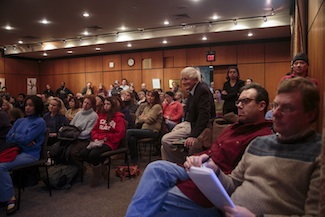 Several hundred residents attended a hastily called information session at the Scarsdale Public Library at 4 pm on Sunday. Mayor Miriam Flisser, joined by Village Trustees David Lee, Kay Eisenman, Bob Harrison, Jon Mark and Bob Steves and State Assemblywoman Amy Paulin, took the stage to answer questions about storm recovery.
Several hundred residents attended a hastily called information session at the Scarsdale Public Library at 4 pm on Sunday. Mayor Miriam Flisser, joined by Village Trustees David Lee, Kay Eisenman, Bob Harrison, Jon Mark and Bob Steves and State Assemblywoman Amy Paulin, took the stage to answer questions about storm recovery.
Residents were clearly tense, frustrated and hoping to get some answers about why Con Edison has not been more responsive to Scarsdale. The Mayor began with an update, reiterating what has been sent in the daily emails from the Village. This was news to some who had not opted-in to receive the information.
The Mayor reported that Con Edison hoped to restore power to all seven schools in Scarsdale so that they could open Monday and to allow voting to take place on Tuesday. As of Monday morning a delayed opening was planned for the district, but around 8 am parents learned that there would be no school at the Edgewood School and Middle School on Monday as Con Edison had not restored power.
The Mayor discussed the collapse of the Optimum Lightpath communications system and said that the emergency operations team had used their
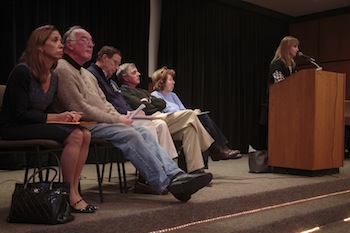
She credited her team with innovations -- such as switching to the analog phone system and hooking up generators to traffic lights. Regarding delays in restoration, she said that the Village could do little to influence Con Edison who only promised to have power back to everyone by November 11, thirteen days after the storm.
Residents asked many questions about what happened and what we could expect and there were few satisfactory answers. Wayne Aaron asked, “Where are we on the list (Con Edison’s list) and Mona Longman asked, “How can we change the timeline?” Linda Shapiro said she spoke to Con Edison at length and that communities like Rye Brook and Pelham had received much faster service. She said, “Why are we on the bottom of the rung?”
The Mayor said that it was not the responsibility of the Village to supply power, and that the “Village could only advocate for Scarsdale.”
Others asked why the Village continues to plant trees in the "right of way" underneath the power lines and if it would be possible for the Village to hire their own crews to repair the power lines. Another said that the utility poles in Scarsdale were old and weak and claimed that other areas have sturdier poles with better footings to withstand higher winds and heavy branches. Peggy Sanchez of Fox Meadow asked if the high school gymnasium could be used by cold residents and the Mayor replied, “We are not able to set up a shelter.” Concerning the use of home generators, someone asked the Mayor if the Village code would soon be revised to allow people who live on small plots to install one. She said that the new law is moving through the system but that “it takes time.”
Paulin fielded several questions and said that she too had no power and was very frustrated with Con Edison’s service. She said, “We met with Con Edison after the last storm and they have not done what they need to do. There will be hearings and the Governor will hold them accountable.” She added that they were able to get Con Edison to open up a few streets in Scarsdale where residents were trapped by fallen trees.
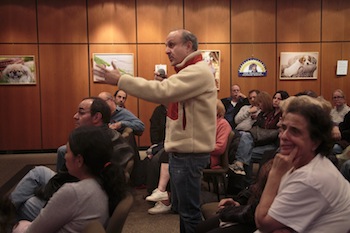
Here are just a few of the many comments the site received following the meeting:
"I found it quite disappointing. This was my first exposure to my elected officials, and wow I found it sobering. No real answers, no foresight to have someone from the Schools present, and a recitation of facts without any real purpose or passion. As many said there, Con Ed has been borderline shameful. But what I also saw was a Mayor who had no ability to take responsibility for being our advocate. Unlike other Mayors in surrounding areas, I don't see her as getting on TV and yelling like hell for us, or refusing to be silent on these "civil" calls. She had little capacity to even empathize with most of the citizens in the meeting. She may be a great administrator, but what we need is a great leader for our Village who refuses to take Con Ed's answers. The only thing Con Ed listens to is pressure, and our local Village leaders are clearly lacking in any ability to apply it effectively. Amy does not fall into that camp. I thought Amy was great, by the way. She was the only one who seemed to get it (amazing how effective a simple "yes, that must be frustrating" can be; something the Mayor should learn). So bottom line, very frustrating. And I think the Mayor needs to go this March, and the star chamber-selected "candidates" selected to run this town should not get too comfortable. Changes are afoot."
“Today's meeting was a disappointment--both for the slow progress of Con Ed to address the problems here in Scarsdale in a timely way, and for the shocking lack of passion, energy, or even simple ability to "feel our pain" by the Mayor and her nameless comrades on the Board. She needs to at least show is that she is truly advocating for us because the demonstration today was a classic example of a nice, earnest administrator completely out of her depth. She needs to show some strength or it will be her last term. You may not be responsible for Con Ed Madame Mayor, but you sure are responsible for making your citizens feel as though they are in the good hands of their local government.”
“Scarsdale is supposed to be a community with superior resources and creativity. Yet we remain tethered to a one-party system and a government-created power distribution monopoly. We should expect our government to lead us with new ideas and solutions. But, despite our leadership's self-congratulations (at all political levels), Scarsdale simply was poorly prepared and is now under-represented in its struggle for remediation resources. Only in school do you get an A for effort - in the real world, especially civic leadership, you only get it it for results, of which to date there are almost zero here in Scarsdale.”
“We are seeing a complete failure of both the Village's professional staff and oversight of the staff by the board of trustees. The professional staff failed in at least two fundamental ways. First, it should have built strong links with ConEd, clearly the most important utility serving the Village's residents. Those links would not have resulted in Scarsdale receiving more resources than we should have been allocated, rather to make sure we receive the resources that we should. Equally as important, those links would allow the staff to learn of ConEd's plan for the region and our village informally, the way all such communication really occurs. Expecting the mayor, who only serves two years, to establish and maintain those links (or serve as an effective point of escalation during emergencies) is not practical. It is only the professional staff, who are typically employed for many years, that can establish these links.
Unfortunately, I can only assume from the lack of meaningful updates from official Scarsdale and the lack of crews in town compared to others in Westchester now being powered back up that those links were simply never built.
The second failure is the lack of planning "business continuity." The instances of failure here are numerous: We have no generators, our website (scarsdale.com) is down, our phone system is down. We are fortunate to have both the emergency notification system and scarsdale10583.com.
Ultimately, the buck stops with the trustees and the mayor, whom we elect first and foremost to make sure our basic needs are met.
Once power is restored, the trees carted away, and our leaves removed, I for one would like to see us (we the people) form an independent commission to review both the state of our Village’s preparedness (the professional staff) and the quality of supervision by the trustees and mayor.”
A second meeting with the Mayor and Trustees will be held tonight, Monday November 5 in the Scott Room of Scarsdale Public Library. Everyone is invited to attend.
Photo credit: Sarah Schuman
The Cold Truth: November 2, 2012
- Details
- Hits: 6020
 Determined to get some answers I went to Village Hall this morning and here is what I learned: Power: The current estimate for restoration of power is 7-10 days. For most the lights will be on again by next weekend – (11/9 or 11/10). Since temperatures will dip to freezing this weekend, anyone who has a place to go – and gas in the car, should consider making the move. Though staying in unheated homes has been bearable up to now, it may become out of the question this weekend.
Determined to get some answers I went to Village Hall this morning and here is what I learned: Power: The current estimate for restoration of power is 7-10 days. For most the lights will be on again by next weekend – (11/9 or 11/10). Since temperatures will dip to freezing this weekend, anyone who has a place to go – and gas in the car, should consider making the move. Though staying in unheated homes has been bearable up to now, it may become out of the question this weekend.
Con Edison Crews: I found three Con Edison trucks on Mamaroneck Road working to repair a damaged utility poll near Murray Hill Road. Today this crew will continue work on Mamaroneck Road to clear it for emergency vehicles and regular traffic. The men confirmed that Hurricane Sandy was the most damaging to Scarsdale of any storm to date and agreed that it will take at least a week to clear the trees and repair the lines. Though they offered no specifics, they said additional crews would be in Scarsdale “soon.”
The Election: We spoke to Village Clerk Donna Conkling who is in touch with the Westchester County Board of Elections. According to her, the Governor’s Office and the NYS Board of Elections are working with Con Edison to open all polling places by Tuesday. The Village has both electronic and lever voting machines but is charged with using the electronic machines for this election, which of course require power. Three of the eight official polling places are open: Crossway Fire House, the Scarsdale Public Library and the Heathcote School. Though it appears doubtful that the five additional polling places will be powered up by Tuesday, Conkling needs to wait for word from the Board of Elections before revising any plans to change polling locations. She promised to keep us informed and we in turn will send any information we receive onto you.
Information: We also spoke to Deputy Village Manager Steve Pappalardo and Assistant Village Manager John Goodwin who were en route to attend the daily briefing at the Public Safety Building. They promised to send daily updates on the crisis to everyone.
No Trick No Treat
- Details
- Hits: 5223
 For the second year in a row, Scarsdale’s streets are too dangerous for Halloween trick or treating. Streets are blocked with tree trunks and debris, and live power lines are loose everywhere. Even in broad daylight, it is difficult to navigate the power lines. Darkness will make Halloween trick or treating particularily perilous. As power is out inside so many homes, it will be hard to know whether or not residents are home – and children are likely to trip in the dark.
For the second year in a row, Scarsdale’s streets are too dangerous for Halloween trick or treating. Streets are blocked with tree trunks and debris, and live power lines are loose everywhere. Even in broad daylight, it is difficult to navigate the power lines. Darkness will make Halloween trick or treating particularily perilous. As power is out inside so many homes, it will be hard to know whether or not residents are home – and children are likely to trip in the dark.
Two neighborhood associations, Drake-Edgewood and Fox Meadow have called for an alternate date for Halloween on Sunday night November 4th. However, according to Lt. Thomas Altizio of the Scarsdale Police Department, power may not be restored by then and too dangerous to trick or treat.
Any solutions? Please comment below or email scarsdalecomments@gmail.com.
Campaign Finance Reform Discussed At League Luncheon
- Details
- Hits: 4338
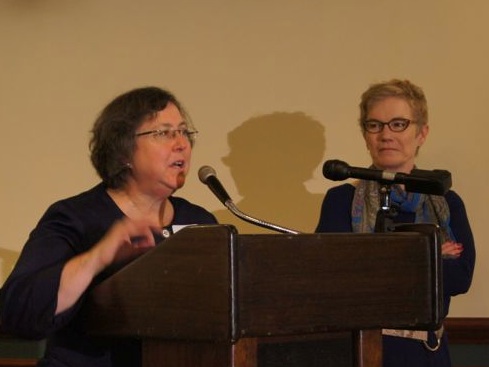 Campaign finance reform and the effect of PAC’s on the election process was the subject of discussion at the League of Women Voters of Scarsdale’s luncheon on Friday October 19 at Scarsdale Golf Club. Guest speaker Susan Lerner is a former trial lawyer who now serves as the Executive Director of Common Cause of New York. According to Lerner, "Big money has long dominated our elections, and the problem has only gotten worse after the Supreme Court's Citizens United ruling in 2010, which paved the way for unlimited amounts of corporate money in our elections. Common Cause New York is working for campaign finance reforms that will help bring government back to the people by reducing the influence of wealthy special interests, expanding public funding of campaigns, and encouraging campaigns to seek funding from a broader base of small contributors."
Campaign finance reform and the effect of PAC’s on the election process was the subject of discussion at the League of Women Voters of Scarsdale’s luncheon on Friday October 19 at Scarsdale Golf Club. Guest speaker Susan Lerner is a former trial lawyer who now serves as the Executive Director of Common Cause of New York. According to Lerner, "Big money has long dominated our elections, and the problem has only gotten worse after the Supreme Court's Citizens United ruling in 2010, which paved the way for unlimited amounts of corporate money in our elections. Common Cause New York is working for campaign finance reforms that will help bring government back to the people by reducing the influence of wealthy special interests, expanding public funding of campaigns, and encouraging campaigns to seek funding from a broader base of small contributors."
According to Lerner, total Super PAC contributions for the upcoming election are $477 million and New York leads the way with a
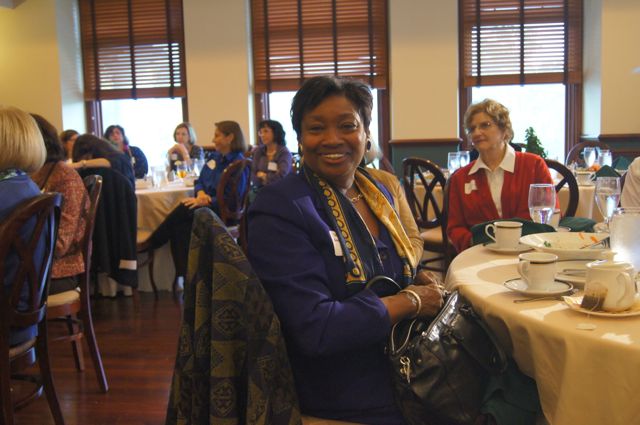
Lerner argues that Instead of serving the democratic process, the millions of dollars spent on political advertising are benefiting campaign consultants and broadcasters -- so the media has little incentive to come out against Super PAC spending.
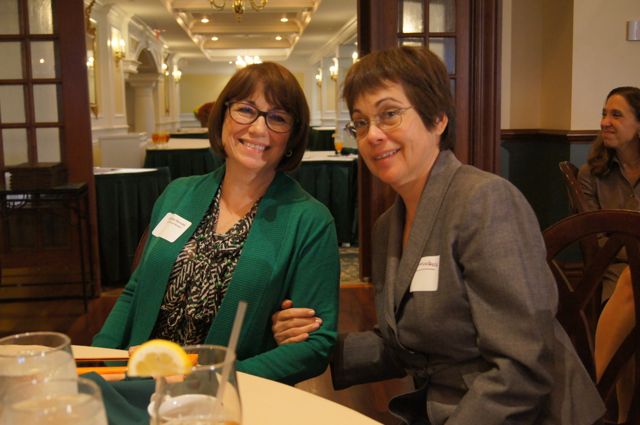
They are lobbying for new disclosure laws to create transparency for entities that make the expenditures. They believe the source of PAC funds and the names of the five largest contributors should appear on the ads so that viewers can assess the ads based on the sources of funding.
They are seeking to reform the campaign finance system and backing an amendment to the constitution to amend the Citizen’s United decision. In Montana and Colorado, voters will have the opportunity to vote for this initiative in the upcoming November election. You can learn more about the AMEND 2012 campaign here: http://amend2012.org/
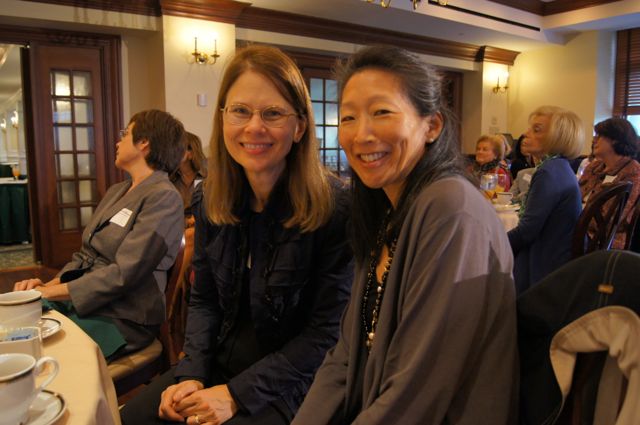
On Thursday, October 25th at 7:30 pm, the League of Women Voters of Scarsdale will sponsor a Candidate Forum in the Scott Room at the Scarsdale Public Library. The public is invited and encouraged to attend. Participants will include Eliot Engel, Joe McLaughlin, and Joe Diaferia, candidates for US Congress, District 16; Andrea Stewart-Cousins, running for New York State Senate, representing District 35, and Amy Paulin, running for New York State Assembly, representing District 88.
Pictured at top: Susan Lerner of Common Cause with League President Marylou Cooper Green










